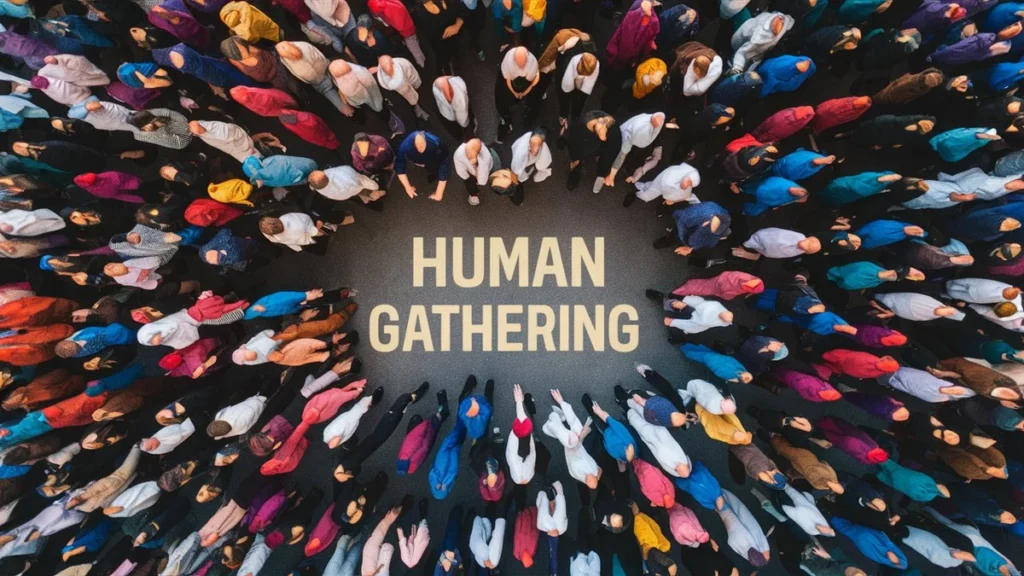Table of Contents
Introduction
In a world where connections and gatherings are crucial to societal development, the authenticity of these gatherings is increasingly being questioned. The phenomenon of fake human gatherings is rising, driven by technological advancements and the influence of social media. This article delves into the complexities of human gatherings, the emergence of fake gatherings, and their profound impact on society.
Understanding Human Gatherings
Definition and Importance
Human gatherings are assemblies of individuals, often for social, cultural, political, or economic purposes. They play a vital role in fostering community, sharing knowledge, and building relationships. From ancient tribal meetings to modern conferences and festivals, gatherings have always been a cornerstone of human interaction.
Historical Context
Historically, human gatherings have been pivotal in shaping societies. Whether it’s the Agora of ancient Greece or the town hall meetings of colonial America, these gatherings have been essential for decision-making, cultural exchange, and communal bonding.
The Rise of Fake Human Gatherings
Technological Advancements
The digital age has brought about significant changes in how gatherings are organized and perceived. Virtual meetings and social media events have blurred the lines between physical and digital interactions. Unfortunately, this has also paved the way for fake human gatherings, where the advertised event is either exaggerated or entirely non-existent.
Social Media Influence
Social media platforms are powerful tools for organizing and promoting events. However, they also facilitate the spread of misinformation. Fake gatherings can gain traction quickly, driven by viral posts and the allure of exclusive experiences, often leaving attendees disappointed or defrauded.
Identifying Fake Human Gatherings
Common Characteristics
Fake gatherings often share common traits: lack of verifiable information, overhyped promises, and vague details about the event’s logistics. They may also feature unrealistic endorsements or testimonials, designed to lure in unsuspecting individuals.
Tools and Techniques
Identifying fake gatherings requires a critical eye. Tools such as reverse image searches, checking the credibility of organizers, and cross-referencing event details can help in spotting fraudulent activities. Awareness and skepticism are key to avoiding deception.
Motivations Behind Fake Human Gatherings
Financial Gains
Many fake gatherings are orchestrated for financial gain. Organizers collect money through ticket sales or donations, only to disappear once they’ve amassed enough funds. These scams can leave participants financially and emotionally drained.
Political Agendas
Fake gatherings can also serve political purposes. They might be used to inflate the apparent support for a candidate or cause, creating a false sense of consensus. This manipulation can sway public opinion and undermine democratic processes.
Social Experiments
Some fake gatherings are staged as social experiments to study human behavior. While these might be academically interesting, they often raise ethical concerns, particularly when participants are unaware of the experiment’s nature.
Case Studies of Fake Human Gatherings
Example 1: The Fyre Festival
The Fyre Festival is a notorious example of a fake gathering. Promoted as a luxury music festival in the Bahamas, it turned out to be a logistical nightmare, leaving attendees stranded without proper accommodation, food, or entertainment. The organizers faced significant legal repercussions, highlighting the severe consequences of fraudulent events.
Example 2: Astroturfing in Political Campaigns
Astroturfing involves creating the illusion of grassroots support for a political candidate or cause. Fake gatherings are staged to appear as spontaneous, popular movements, misleading the public and influencing election outcomes.
The Impact of Fake Human Gatherings
On Individuals
Individuals duped by fake gatherings experience financial loss, emotional distress, and trust issues. The disappointment and embarrassment can have long-lasting effects, making them wary of future events.
On Society
At a societal level, fake gatherings erode trust in genuine events and organizations. They contribute to a culture of skepticism and can diminish the perceived legitimacy of real movements and causes.
Psychological Effects
Trust Issues
Repeated exposure to fake gatherings can lead to widespread trust issues. People become more skeptical of advertised events, which can hinder community engagement and participation in legitimate gatherings.
Emotional Manipulation
Fake gatherings often exploit emotional triggers, such as the fear of missing out (FOMO) or the desire for exclusivity. This emotional manipulation can leave lasting psychological scars on participants.
Legal and Ethical Considerations
Current Laws
While laws against fraud and false advertising exist, they often struggle to keep up with the innovative tactics used by scammers. Legal frameworks need continuous updates to address the evolving nature of fake gatherings.
Ethical Implications
Beyond legalities, the ethics of organizing fake gatherings are highly questionable. Deceiving individuals for profit, political gain, or academic curiosity violates principles of honesty and respect, undermining societal trust.
Preventing Fake Human Gatherings
Awareness and Education
Raising awareness about the existence and characteristics of fake gatherings is crucial. Educational campaigns can equip individuals with the knowledge to recognize and avoid scams.
Technological Solutions
Technological solutions, such as blockchain for ticket verification and AI-driven event authenticity checks, can help prevent fake gatherings. These innovations can provide secure, transparent methods for event management.
Role of Media in Fake Human Gatherings
Media’s Influence
The media plays a significant role in either amplifying or mitigating the impact of fake gatherings. Sensationalist reporting can give undue attention to fraudulent events, while responsible journalism can help expose and prevent them.
Responsible Reporting
Journalists and media outlets have a responsibility to verify the authenticity of events before promoting them. Accurate reporting can safeguard the public from scams and build trust in the media.
Community Responses
Grassroots Movements
Community-driven initiatives can effectively counter fake gatherings. Grassroots movements that promote transparency and accountability in event organizations can help restore public trust.
Collective Action
Collective action, such as boycotts of known fraudulent organizers and support for verified events, empowers communities to take a stand against deception.
Future of Human Gatherings
Predictions
As technology continues to evolve, so too will the methods used to organize and verify gatherings. The future may see a blend of virtual and physical events, with enhanced security measures to ensure authenticity.
Technological Integration
Incorporating advanced technologies like blockchain and AI into event planning and promotion can help safeguard against fake gatherings. These tools can provide reliable verification methods, ensuring that advertised events are genuine.
Conclusion
Fake human gatherings are a troubling byproduct of our technologically advanced and interconnected world. They exploit trust and emotions for financial, political, or experimental gain, leaving a trail of disillusionment and skepticism. By raising awareness, leveraging technology, and fostering community resilience, we can combat the spread of fake gatherings and ensure that our social interactions remain authentic and meaningful.
Read Also:-JOHNNY DEPP
FAQs
-
How can one spot a fake human gathering?
Look for vague details, unverified endorsements, and unrealistic promises. Verify the organizers’ credibility and use tools like reverse image searches to check the authenticity of promotional materials.
-
What are the legal consequences of organizing a fake gathering?
Organizers of fake gatherings can face charges of fraud, false advertising, and breach of contract. Penalties may include fines, restitution, and imprisonment.
-
How has social media contributed to the rise of fake gatherings?
Social media facilitates the rapid dissemination of information, making it easier for fake gatherings to gain traction. The viral nature of posts can amplify the reach of fraudulent events.
-
What can individuals do to protect themselves from fake gatherings?
Stay informed, verify event details through multiple sources, and be skeptical of overly hyped or exclusive-sounding events. Use technology to check the authenticity of tickets and promotions.
-
Are there any benefits to fake human gatherings?
While there are no ethical benefits, fake gatherings can sometimes highlight vulnerabilities in our trust systems, prompting improvements in verification processes and public awareness.







